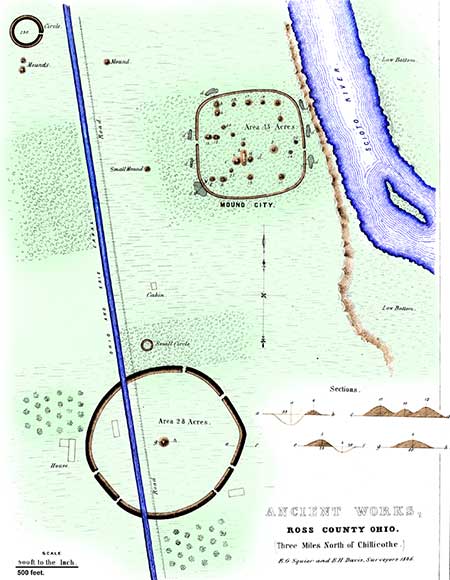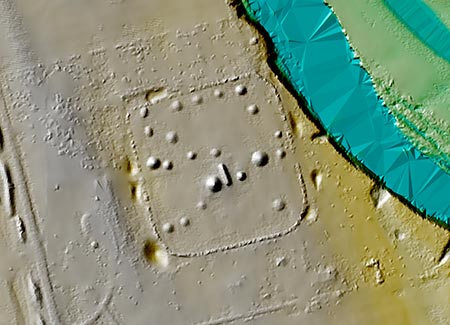PLATE XIX.41
Mound City, Ross County, Ohio.
In outline it is nearly square, with rounded angles, and consists of a simple embankment, between three and four feet high, unaccompanied by a ditch. Its site is the beautiful level of the second terrace, and it is still covered with the primitive forest.
The first and most striking feature in connection with this work is the unusual number of mounds which it contains. There are no less than twenty-four within its walls. All of these, as above observed, have been excavated, and the principal ones found to contain altars and other remains, which put it beyond question that they were places of sacrifice, or of superstitious origin. [The evidence in support of this conclusion will appear in a subsequent chapter on the mounds and their purposes.]
These mounds seem placed generally without design in respect to each other, although there is a manifest dependence between those composing the central group, and between those numbered 4 and 5, and 12 and 13. From the principal mound, numbered 7 in the plan, after the fall of the leaves, a full view of every part of the work and of its enclosed mounds is commanded. This mound is seventeen feet high, with a broad base nearly one hundred feet in diameter. The long mound, No. 3, is one hundred and forty feet long, by eighty wide at the base, and ten feet in average height. Broad and deep pits, from which the earth for the construction of the mounds was taken, surround the work. The one occurring at the south-western angle, and of which a b exhibits a vertical section, is at this time eighteen feet deep, by one hundred and twenty feet in width, and over two hundred feet in length. The accumulation of vegetable deposit at the bottom is found, by excavation, to be not less than thirty inches,—a fact which may assist in an approximate estimate of the age of this monument.
The absence of an exterior ditch, as also the fact that the work is commanded from a slightly elevated terrace half a bow-shot to the left, seems sufficient to establish that it was not designed for defence. The skill, which the illustrations of a previous chapter convince us the mound-builders possessed in selecting and fortifying their military positions, is in no degree displayed in this instance. Taking in view also the character and purposes of the mounds as disclosed by excavation, we are certainly well warranted in classing this as a sacred work.
The custom of enclosing the Adoratorios or Teocallis, upon which their sacrifices and religious rites generally were practised, was universal among the Mexicans. The open temples of the ancient Britons were embraced within parapets of earth, usually, if not always, circular in form. The "tabooed" grounds or sacred places of the Pacific Islanders, are also surrounded, if not by earthen, by stone walls or by palisades.
One fourth of a mile to the north-west of this work is ay small circle two hundred and fifty feet in diameter, accompanied by two large mounds.
About the same distance to the south is another work of somewhat similar outline, but of larger size. It is, moreover, surrounded by a ditch. Its position, in respect to "Mound City," requires that it should be noticed here. The plan and sections will convey a sufficiently accurate idea of its form and construction. Unlike the works obviously of sacred origin, which, if they possess a ditch at all, have it interior to the wall, this has an outer fosse; a circumstance which would seem to favor the suggestion of a defensive origin. On the other hand, it has a mound, very nearly if not exactly in its centre, which was clearly a place of sacrifice. It was found, upon excavation, to contain an altar singularly constructed of small stones, carefully imbedded in sand, forming a paved concavity, upon which were the usual traces of fire, and the remains of the sacrifice. This mound will be minutely noticed elsewhere.
41. These works are marked E and F respectively, in Map, Plate II.



